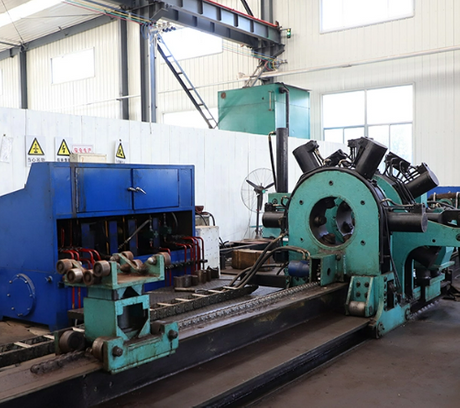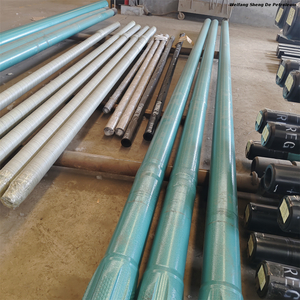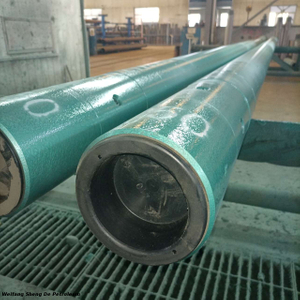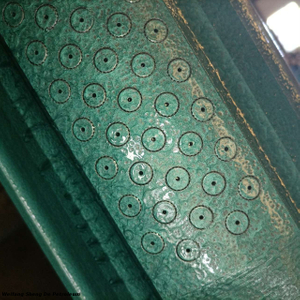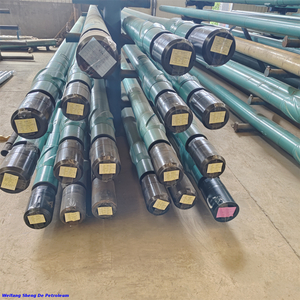Positive displacement motors (PDMs) are critical tools in various industrial operations, particularly in oil and gas drilling. These motors use hydraulic fluid to generate mechanical power, providing reliable and consistent energy to perform tasks like drilling, milling, and wellbore cleaning, even under extreme conditions.
In this article, we'll explore the working principle of PDMs, from their rotor/stator configuration to their ability to convert fluid pressure into torque. We'll delve into their key applications in directional drilling, performance drilling, and wellbore cleanouts. Additionally, you'll learn about the advantages of using PDMs.
What is a Positive Displacement Motor (PDM)?
Positive displacement motors (PDMs) are essential components used in various industries, particularly in oil and gas drilling. These motors convert hydraulic fluid into mechanical power, enabling them to drive tools and equipment efficiently. Their design allows for the reliable transmission of power, even under high pressure and extreme conditions. A Positive Displacement Motor (PDM) is a type of motor that converts hydraulic fluid pressure into mechanical torque. The motor's function is based on a rotor and stator mechanism. When the hydraulic fluid is pumped through the motor, it moves the rotor inside the stator, generating mechanical power. This process allows the motor to drive drill bits and other equipment without relying on surface rotation.
How Do Positive Displacement Motors Work?
Positive displacement motors (PDMs) are powerful and efficient tools in various industrial applications, particularly in oil and gas drilling. These motors are designed to convert hydraulic fluid pressure into mechanical energy. The process relies heavily on the interaction between the rotor and stator, which work together to produce movement. Let's dive deeper into how this mechanism functions and how it allows PDMs to operate effectively under challenging conditions.
The Rotor and Stator Mechanism
At the heart of a positive displacement motor is the rotor and stator mechanism, which is responsible for converting hydraulic fluid into mechanical power.
Stator: The stator is the outer part of the motor and is made from a molded elastomer with multiple lobes. This elastomer casing is protected by a metal casing that ensures durability even in high-pressure environments.
Rotor: Positioned inside the stator, the rotor features fewer lobes than the stator, creating cavities between the two components.
As drilling fluid is pumped into these cavities, it is pressurized, causing the rotor to rotate. The force generated by this pressurized fluid drives the motor's movement, which, in turn, powers the drill bit or other downhole tools.
The unique feature of PDMs lies in their ability to maintain a constant torque despite variations in speed. Unlike turbines, where an increase in speed typically results in reduced torque, PDMs allow for precise control over both factors. This makes them highly effective in applications requiring consistent, reliable power.
Torque and Speed Optimization in PDMs
One of the defining characteristics of PDMs is their ability to optimize torque and speed to suit different drilling operations. This is largely dependent on the rotor and stator configuration. The number of lobes on the rotor and stator plays a critical role in determining the motor's torque and speed output.
Higher Number of Lobes (Increased Torque): When the rotor and stator have more lobes, the motor can generate greater torque. This configuration is ideal for applications where more power is needed, such as drilling through harder rock formations. Higher torque allows the motor to overcome resistance from tough materials, ensuring that the drill bit continues to perform efficiently.
Lower Number of Lobes (Increased Speed): A rotor/stator configuration with fewer lobes increases the speed of the motor but reduces torque. This is useful in applications where speed is a priority, such as when drilling in softer formations or when faster penetration is required.
The ability to fine-tune the rotor/stator configuration makes PDMs versatile tools in the drilling industry. By adjusting the number of lobes, operators can optimize the motor's performance to suit the specific requirements of the job.
In addition to this, PDMs are also able to operate in both low- and high-flow conditions, making them adaptable for various drilling fluids and pressures. This flexibility is critical for maintaining drilling performance across different wellbore conditions.
![PDM PDM]()
Key Factors Influencing PDM Performance
Fluid Flow Rate: The speed at which drilling fluid flows through the motor affects both torque and speed. Higher flow rates typically result in higher bit speed but can reduce torque. Conversely, lower flow rates can increase torque but reduce speed.
Pressure Differential: The difference in pressure between the inlet and outlet of the PDM impacts the amount of torque generated. A larger pressure differential typically results in higher torque output, which is beneficial in applications requiring additional power.
By understanding and controlling these factors, PDMs can be finely tuned to maximize performance, whether it's increasing the rate of penetration, enhancing torque output, or optimizing bit speed.
In summary, the rotor and stator design of PDMs, along with the ability to adjust configuration based on the drilling needs, allows for highly efficient and reliable drilling operations. Whether it's generating high torque for tough formations or high speed for faster penetration, PDMs are capable of delivering the necessary power for various drilling applications.
Applications of Positive Displacement Motors
Positive displacement motors (PDMs) are essential in various industrial operations, particularly in the oil and gas sector. Their ability to convert hydraulic fluid into mechanical power ensures their wide use across multiple applications. Here is a detailed look at the different areas where PDMs are used.
Oil and Gas Drilling
Directional Drilling:
PDMs are fundamental to directional drilling, where the motor drives the drill bit during "sliding mode" operations. In this scenario, the drillstring is not rotated from the surface; instead, the PDM rotates the bit independently by using hydraulic power from the drilling fluid. This allows drilling at various angles or in specific directions, crucial for operations that require precise control over the well path. PDMs enable these precise movements without requiring a rotating drillstring from the surface, which is especially beneficial in challenging terrains like horizontal or deviated wells.
Performance Drilling:
Performance drilling focuses on maximizing drilling efficiency and minimizing the time required to reach the target depth. PDMs provide continuous, reliable torque, which is key for increasing the rate of penetration (ROP). The consistent power generation from PDMs accelerates the drilling process, enabling faster speeds and more cost-effective operations. PDMs can handle extreme conditions while providing the necessary torque to break through tough formations, reducing the time and cost associated with drilling in hard rock or other challenging formations.
Straight Hole Drilling:
In straight-hole drilling, PDMs offer significant advantages by minimizing the need for drillstring rotation. This reduction in rotation leads to less wear on the casing, helping extend the life of equipment and ensuring a more efficient drilling process. Since PDMs drive the bit directly without rotating the drillstring excessively, they reduce friction and casing damage, lowering maintenance costs and extending the operational life of the well.
Coring and Underreaming:
PDMs are critical for operations like coring and underreaming. In coring, operators need to extract rock samples, often from deep below the surface. The steady power generated by PDMs ensures that these operations are performed accurately and efficiently. Similarly, underreaming involves enlarging the borehole diameter, and PDMs can provide the torque and pressure required to achieve this task. Their ability to maintain consistent torque under varying conditions makes them ideal for these specialized operations, which require precise control and high power.
Milling Operations:
Milling operations are used to grind, cut, or clean rock and other materials from the wellbore. PDMs are ideal for these tasks due to their high torque output. The steady and powerful rotation provided by PDMs enables tools to perform milling efficiently, even in tough conditions. Whether cutting through hard rock or removing debris from the wellbore, PDMs ensure that the process is completed quickly and with minimal wear on equipment.
![PDM PDM]()
Optimizing Drilling Performance
Increasing Rate of Penetration (ROP):
One of the most important benefits of using PDMs is their ability to increase the rate of penetration (ROP). Faster drilling means lower operational costs and quicker well completion. By maintaining consistent power and torque, PDMs help operators drill faster, even in tough formations. In performance drilling, where maximizing ROP is a key objective, PDMs provide the reliability and stability necessary for achieving high-speed drilling without compromising the integrity of the wellbore.
Reducing Casing Wear:
PDMs reduce the amount of drillstring rotation, which directly decreases friction between the drillstring and casing. This reduction in friction is crucial in preventing casing wear, a major issue in deep-well drilling. Casing damage can cause significant downtime, repair costs, and operational delays. By minimizing casing wear, PDMs help operators save on repairs and extend the lifespan of the wellbore infrastructure. This is especially valuable in high-cost drilling operations, where maintaining equipment integrity is crucial for profitability.
Enhanced Drilling Stability:
Unlike other motor types that may struggle with fluctuating torque levels, PDMs deliver a consistent torque throughout the operation. This stability ensures smooth drilling even in challenging geological conditions. PDMs are particularly beneficial in operations where constant power is required to avoid fluctuations that could lead to tool failure. Their ability to maintain steady power reduces the risk of operational interruptions and enhances the overall stability of the drilling process.
Hydraulic Power Units and Wellbore Cleaning
Hydraulic Power Generation:
PDMs play a key role in generating hydraulic power for wellbore cleaning and other downhole tasks. By converting hydraulic fluid into mechanical power, PDMs drive cleaning tools and other equipment used to maintain the wellbore's integrity. This function is vital for preventing the accumulation of debris, cuttings, and mud, which can obstruct the wellbore and reduce production efficiency. PDMs ensure that cleaning tools operate effectively, keeping the wellbore free from blockages and improving overall production.
Wellbore Cleanouts:
During drilling and production operations, debris such as cuttings, mud, and other materials often accumulate in the wellbore. PDMs are used to power cleaning tools that remove these materials, ensuring that the wellbore remains clear. This is critical for maintaining smooth operations and preventing downtime due to blockages. Their ability to provide continuous, reliable torque makes PDMs highly effective for wellbore cleanouts, allowing for uninterrupted production and optimal performance.
Other Industrial Applications
Coiled Tubing Operations:
PDMs are frequently used in coiled tubing operations, which are employed for well intervention tasks. Coiled tubing allows for various applications such as well cleaning, stimulation, and even drilling. PDMs can drive tools through coiled tubing, eliminating the need for traditional rigs. This flexibility makes coiled tubing operations more efficient, cost-effective, and less dependent on complex rig setups. By providing consistent power, PDMs enhance the versatility of coiled tubing operations, making them ideal for a wide range of tasks.
Underbalanced Drilling:
Underbalanced drilling is a technique where the pressure in the wellbore is kept lower than the pressure of the surrounding formation. This method helps prevent formation damage and improves drilling efficiency. PDMs are well-suited for underbalanced drilling operations because they can operate reliably under varying pressure conditions. Their ability to maintain torque while handling fluctuating pressures ensures that drilling continues smoothly, even under challenging conditions.
High-Temperature and High-Pressure Environments:
PDMs are designed to withstand extreme conditions, including high temperatures and high pressures. This makes them ideal for deep-well drilling and geothermal applications, where temperatures and pressures are significantly higher than in standard drilling operations. PDMs maintain their efficiency and power output in these harsh environments, ensuring reliable performance even in the most challenging conditions.
Multiple Rotor/Stator Configurations:
The versatility of PDMs is also evident in their rotor/stator configurations. By adjusting the number of lobes on the rotor and stator, operators can optimize the motor's output to suit their specific drilling requirements. This customization allows PDMs to be used in a wide range of applications, from light-duty drilling tasks to heavy-duty operations in challenging formations. The ability to fine-tune the motor's performance ensures that PDMs can handle diverse operational needs with ease.
![PDM PDM]()
Advantages of Positive Displacement Motors
Efficiency and Power
PDMs provide greater power output compared to other motor types, especially in high-torque, high-pressure environments. This makes them ideal for demanding tasks where consistent and reliable power is essential.
In applications like directional drilling, performance drilling, and milling, PDMs deliver the torque required to maintain high operational efficiency, even under challenging conditions.
Reduced Wear and Tear
One of the standout features of PDMs is their low friction bearing sections. These help reduce power losses, resulting in less heat generation and lower wear. As a result, PDMs last longer and require less maintenance.
Components like titanium flex shafts and chrome or tungsten carbide-coated rotors enhance the motor's durability, ensuring it can withstand prolonged use in harsh environments, ultimately lowering downtime.
Corrosion Resistance
PDMs are constructed using corrosion-resistant materials, ensuring their longevity and operational stability, even in environments exposed to harsh chemicals or extreme temperatures. This resistance to corrosion is particularly important in oil and gas drilling operations, where PDMs are frequently exposed to abrasive fluids and high temperatures.
Common Issues with Positive Displacement Motors
Overloading and Potential Failures
Overloading is one of the most common issues that can damage a PDM. When the motor is exposed to excessive torque or pressure beyond its rated capacity, it can lead to catastrophic failure. However, modern PDMs are equipped with overload protection systems to prevent such damage. These systems help by automatically adjusting the motor's load, ensuring the motor does not exceed its safe operational limits.
If overload protection is bypassed or malfunctions, the motor can overheat, leading to damage to its bearings or stator/rotor components. It is essential to regularly inspect the protection system and ensure it is functioning correctly.
Friction Buildup and Maintenance Tips
Another common issue is friction buildup, which occurs over time as the rotor and stator move against each other. This can cause increased wear, leading to efficiency losses and potential motor failure. To minimize this, proper lubrication is crucial. Using high-quality synthetic oils and ensuring consistent fluid flow are vital steps in reducing friction.
Routine maintenance should include:
Checking for signs of excessive wear: Look for signs of degradation in the stator and rotor, especially at high-stress points.
Regular oil changes: Ensure that the oil used is clean and at the proper viscosity to lubricate the internal components efficiently.
Inspections for debris or blockages: Any blockages can prevent fluid from flowing properly, causing stress on the motor.
Conclusion
Positive displacement motors (PDMs) are crucial in industrial operations, especially in oil and gas drilling. They efficiently convert hydraulic fluid into mechanical power for tasks like drilling and milling. PDMs offer consistent performance, reliability, and efficiency under challenging conditions. Regular maintenance and overload protection are essential to ensure longevity and prevent failure. By understanding their applications and potential issues, operators can maximize the performance and lifespan of PDMs in various drilling operations.
FAQs
Q: What is a Positive Displacement Motor (PDM) used for?
A: Positive displacement motors (PDMs) convert hydraulic fluid power into mechanical energy, driving tools such as drill bits in drilling operations. They are essential for tasks like directional drilling, coring, milling, and wellbore cleaning.
Q: How do Positive Displacement Motors (PDMs) work?
A: PDMs use a rotor and stator configuration where the rotor moves within the stator to create cavities filled with drilling fluid. This fluid under pressure forces the rotor to rotate, generating torque and mechanical power for drilling and other applications.
Q: What are the benefits of using Positive Displacement Motors (PDMs)?
A: PDMs provide consistent and reliable power, increase drilling efficiency by improving the rate of penetration, reduce casing wear, and enhance wellbore stability. They also operate well in high-pressure and high-temperature environments, making them suitable for tough drilling conditions.













